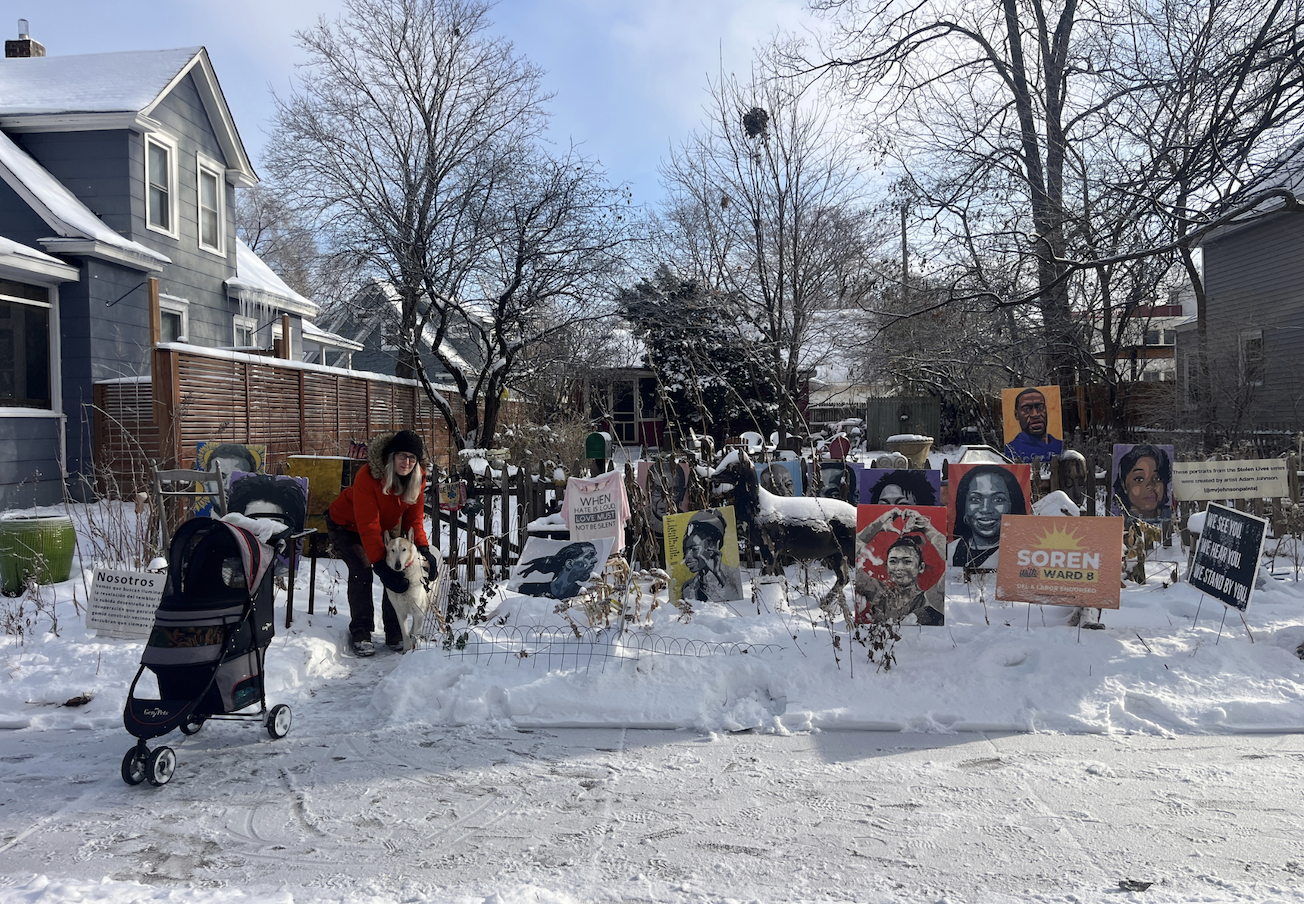Southwest Minneapolis is home to 49 places deemed significant by the National Register of Historic Places. Last week we are explored 20 historical places in the northern region of Southwest. Two weeks ago we looked at 13 places located in Loring Park. This week, we explore historical places in the southern part of Southwest, completing our tour of the historical places in Southwest.
We start off in the Lyndale neighborhood.
Lyndale
34. Stewart Memorial Presbyterian Church, added to the National Register of Historic Places on November 28, 1978: Another Prairie School style building designed by the firm of Purcell & Feick, the 1910 presbyterian church is unique in that the design of the building is a far cry from the Romanesque Revival style churches built throughout the several prior decades in Minneapolis. Purcell & Feick boasted to the media that every line from the basement to the roof was either perpendicular or horizontal. Since its construction, the original design and integrity of the building has remained as sleek and modern stalwart in the Lyndale neighborhood.

South Uptown
35. White Castle Building Number 8, added to the National Register of Historic Places on October 16, 1986: If you’ve ever walked through the South Uptown neighborhood, you are well aware of the unmistakable crenelated towers and parapets of the White Castle building at the northwest corner of Lyndale and West 33rd Street. The prefabricated restaurant building first opened in 1936 next to the University of Minnesota’s east bank campus, replacing a previous White Castle building. In 1950, the White Castle Building No. 8 moved to Marcy-Holmes where it served the neighborhood for 33 years until its closure in 1983 when a new, larger White Castle was opened down the road. In 1984, the Landmark Preservation Commission purchased the White Castle No. 8 building for $10, spending another $10,000 to move the building to its current location in South Uptown.

Kingfield
36. Church of the Incarnation and Rectory, added to the National Register of Historic Places on January 11, 2022: Dominating the southeast intersection of Pleasant Avenue and West 38th Street, the Italian Renaissance style church was constructed of brick and stone in 1918. The church’s entrance features decorative arched brickwork, narrow arched windows, and an intricate circular rose window. The church was designed by architect Emmanuel Louis Masqueray, who is also responsible for the design of the Basilica of Saint Mary.

East Harriet
37. Theodore Wirth House - Administration Building, added to the National Register of Historic Places on June 7, 2002: Located in Lyndale Farmstead Park, the home was built for Theodore Wirth, superintendent of the Minneapolis Park and Recreation Board from 1906 through 1935. Wirth continued on as superintendent emeritus until his passing in 1949. The house itself was built in a Mission Revival/Colonial style in 1910 by architect Lowell Lamoreaux, who also designed the Eitel Hospital and the Semple House.
After Wirth’s passing, the residence continued the tradition as the home for the superintendent of the park board through the 1990s.

38. Lakewood Cemetery Memorial Chapel, added to the National Register of Historic Places on October 20, 1983: What if you could gather a who’s who of Minneapolis’ history all in one place? Well, that would be a good description of Lakewood Cemetery. Tucked away between Bde Maka Ska and Lake Harriet, this cemetery is the final resting place of famed Minnesotans such as Theodore Wirth, Bobby Marshall, Rudy Perpich, and Harry Wild Jones, to name a few. Lakewood Cemetery was part of the rural cemetery movement of the late 1800s. The cemetery features rolling landscapes with native plants and a private pond.
Although the cemetery offers many beautifully carved headstones, statues, and tombs; the most famous structure is undoubtedly the Byzantine stylized Lakewood Cemetery Memorial Chapel, built between 1908 and 1910 by architect Harry Wild Jones. Jones drew inspiration from the Hagia Sophia Grand Mosque in Istanbul when designing the chapel. The interior of the chapel was designed by Charles R. Lamb, who employed several venetian artists to create the over ten million tiles that adorn the chapel’s dome and interior. When completed, the chapel was the only building in the United States with a mosaic interior.

Linden Hills
39. Interlachen Bridge, added to the National Register of Historic Places on November 6, 1989: By 1879, the Lyndale Railway Company, later the Twin Cities Rapid Transit Company, laid track on what would later become the Como-Harriet streetcar line from downtown Minneapolis to the area between Bde Maka Ska and Lake Harriet. Here, the neighborhoods of Linden Hills and Cottage City began to develop.
As more individuals moved into the area, there was a realized need for a bridge to span the streetcar line between the lakes to reduce traffic. Thus, William S. Hewett was retained to design and construct a sizable bridge that could accommodate pedestrian, horse, and vehicular traffic. Opened in 1900 at a cost of roughly $6,900, the Interlachen Bridge remains as a virtually unaltered example of a reinforced concrete arched bridge.

40. Como-Harriet Streetcar Line, added to the National Register of Historic Places on October 17, 1977: Once extending from downtown Minneapolis through Linden Hills, the Como-Harriet Streetcar Line operated passenger service beginning in the 1880s through 1954 when the city nixed the streetcars. After the public displayed an interest and enthusiasm in restoring a portion of the streetcar line for leisurely use, the Minneapolis Park and Recreation Board acquired a portion of the original Como-Harriet line from Lakewood Cemetery to the Queen Avenue bridge in the 1970s.
The Como-Harriet line has one station in operation at West 42nd Street. The original station designed by Harry Wild Jones operated a dining room, candy store, and jail cell in the basement for the Minneapolis Park Police. This station stood until the end of streetcar service in 1954. The station that is now operated by the Minnesota Streetcar Museum at this location is a replica of an early 1900s station that was replaced by the Harry Wild Jones structure in 1912.

41. Queen Avenue Bridge, added to the National Register of Historic Places on November 6, 1989: Added to the register the same day as the Interlachen Bridge; the Queen Avenue Bridge is the third-oldest reinforced concrete arch bridge in Minnesota. The single-span, barrel-arch bridge was designed by Charles Shelpley and constructed in 1905. Today, the Minnesota Streetcar Museum’s car barn is located within the bridge’s underpass.
42. Loren L. Chadwick Cottages, added to the National Register of Historic Places on February 9, 1984: A pristine remnant of Cottage City, a former neighborhood on the south side of Bde Maka Ska intended for modest lake cottages and three-season cabins. At 2617 West 40th Street, two of the distinctive 1902 cottages from Cottage City were conjoined in 1972 to form the Chadwick Cottages.

43. Minneapolis Fire Department Station 28, added to the National Register of Historic Places on November 12, 1993: Built in 1914 to serve as the fire station for the Linden Hills neighborhood, the station was the first to be designed for motorized fire engines. The Minneapolis Fire Department has since moved their operations, the former station 28 at 2724 West 43rd Street is now home to The Harriet Brasserie with offices occupying the second story.

44. Linden Hills Branch Library, added to the National Register of Historic Places on May 26, 2000: The library at 2900 West 43rd Street was built in 1931 in a Tudor Revival style by Joseph Victor Vanderbilt. The building is primarily composed of red brick and limestone with a slate roof. Since its inception, the library has been a cultural and social center for the Linden Hills neighborhood.

45. Lake Harriet Methodist Episcopal Church, added to the National Register of Historic Places on May 19, 2014: The 1916 structure at 4401 Upton Avenue South was designed in a Classical Revival style by architecture firm Fulton & Butler. The building’s significant features include the portico of ionic columns at the primary entrance and the large central domed roof that can be seen from up to a mile away.
The Lake Harriet Methodist Episcopal Church left the 4401 Upton South building in 1954 after a new, larger church building was constructed for the congregation about a mile to the southwest. Today, the church is occupied by the Lake Harriet Spiritual Community.

Lynnhurst
46. Floyd B. Olson House, added to the National Register of Historic Places on December 31, 1974: The former home of the Minnesota governor from 1931-1936 Floyd B. Olson is located at 1914 West 49th Street. The 1922 home is a characteristic Minneapolis craftsman-bungalow with low pitched gable roofing, stucco and wood siding, horizontal proportions, and an open floor plan.
The home was placed on the National Register for Floyd B. Olson’s influential state leadership. Olson served as the Minnesota Governor for three terms and served as Hennepin County Attorney for a decade.

47. Charles and Grace Parker House, added to the National Register of Historic Places on June 11, 1992: Located at 4829 Colfax Avenue South, the Parker House is another exemplary example of the Prairie School House architecture by the Purcell, Feick & Elmslie firm. The home was built in 1913 for Charles Parker, a Minneapolis businessman and civic leader of the community.

Tangletown
48. The Washburn Park Water Tower, added to the National Register of Historic Places on October 6, 1983: Strategically located at the precipice of one of the highest hills in south Minneapolis, the Washburn Park Water Tower is an unmistakable landmark. The water tower was designed by Harry Wild Jones, William S. Hewitt, and John K. Daniels in 1931 to replace a former water tower that was at the same location in 1893.
The water tower is famed for its eight hooded knights that are sculpted around the base of the tower. Known as the Guardians of Health, these knights were supposedly placed around the tower to protect the water supply from pollutants and contaminants. Perched high above the Guardians of Health are eight concrete eagles that lookout over south Minneapolis.

49. Harry Wild Jones House, added to the National Register of Historic Places on June 7, 1976: At 5101 Nicollet Avenue, the Harry Wild Jones House was one of the first homes in the Tangletown area when built in 1887. His home set the tone for the housing stock design of Tangletown. Harry Wild Jones was a famed architect of his day; he is responsible for designing several NRHP-designated buildings throughout the Twin Cities.


.jpg)







